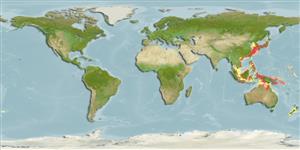Environment: milieu / climate zone / depth range / distribution range
Ökologie
seewasser demersal; tiefenbereich 38 - 150 m (Ref. 9774). Tropical
Western Pacific: Japan, Korea, and Indo-China.
Size / Gewicht / Alter
Maturity: Lm ? range ? - ? cm
Max length : 26.8 cm TL Männchen/unbestimmt; (Ref. 106388); common length : 12.0 cm SL Männchen/unbestimmt; (Ref. 9774); max. veröff. Gewicht: 208.70 g (Ref. 106388); max. veröff. Alter: 3.00 Jahre (Ref. 47703)
Rückenflossenstacheln (insgesamt): 0; Rückenflossenweichstrahlen (insgesamt): 68-76; Afterflossenstacheln 0; Afterflossenweichstrahlen: 53 - 57; Wirbelzahl: 35 - 36. Body pale brownish, with 2 ocelli above and below lateral line and 1 ocellus on posterior third of straight section of lateral line. Teeth in upper jaw small and close-set. Gill rakers long and slender. Soft ray count of pectoral fin refers to that on ocular side (Ref 9774). Body with many ocelli (Ref. 559).
Inhabits mud and sand bottoms of the continental shelf (Ref. 9774, 11230). Feeds on small benthic crustaceans and fishes (Ref. 9774). Marketed fresh and salt-dried (Ref. 9774).
Life cycle and mating behavior
Geschlechtsreife | Fortpflanzung | Ablaichen | Eier | Fecundity | Larven
Distinct pairing (Ref. 205).
Robins, C.R., R.M. Bailey, C.E. Bond, J.R. Brooker, E.A. Lachner, R.N. Lea and W.B. Scott, 1991. World fishes important to North Americans. Exclusive of species from the continental waters of the United States and Canada. Am. Fish. Soc. Spec. Publ. (21):243 p. (Ref. 4537)
IUCN Rote Liste Status (Ref. 130435)
Bedrohung für Menschen
Harmless
Nutzung durch Menschen
Fischereien: kommerziell
Mehr Information
ReferenzenAquakulturAquakultur ProfilZuchtlinienGenetikElectrophoresesVererbbarkeitKrankheitenVerarbeitungNutrientsMass conversion
Tools
Zusatzinformationen
Download XML
Internet Quellen
Estimates based on models
Preferred temperature (Ref.
123201): 16.7 - 28.1, mean 26 °C (based on 299 cells).
Phylogenetic diversity index (Ref.
82804): PD
50 = 0.5000 [Uniqueness, from 0.5 = low to 2.0 = high].
Bayesian length-weight: a=0.00631 (0.00372 - 0.01070), b=3.15 (3.00 - 3.30), in cm total length, based on LWR estimates for this species & Genus-body shape (Ref.
93245).
Trophic level (Ref.
69278): 4.0 ±0.67 se; based on food items.
Widerstandsfähigkeit (Ref.
120179): hoch, Verdopplung der Population dauert weniger als 15 Monate. (tmax=3).
Fishing Vulnerability (Ref.
59153): Low vulnerability (17 of 100).
